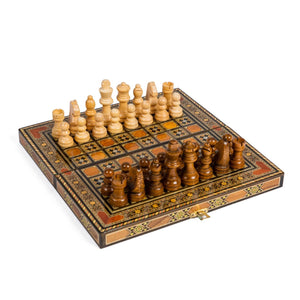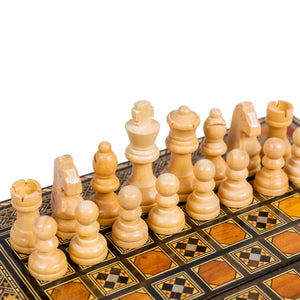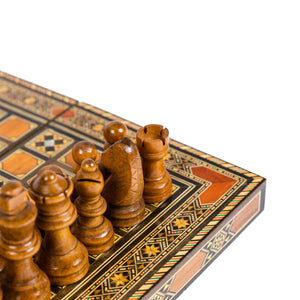Your Cart is Empty








Chess game made by hand in Syria, where inlay is traditionally worked and where this type of manual work has its origins.
Made of wood and inlay.
Available in 3 sizes, you can also buy the set of 3 boards (best price).
Made in Syria.
DIMENSIONS
Small: 21cm long, 10cm wide, 4cm thick
Medium: 30cm long, 15cm wide, 5cm thick.
Large: 40cm long, 20cm wide, 7cm thick.
* The board DOES include chess pieces.
ABOUT SYRIAN TARACE
Inlay is an artisanal technique applied to covering floors, walls, furniture, sculptures and artistic objects. In the work, pieces cut from different materials (stones, marble, wood, metals...) are used, which are fitted into a support until the decorative design is made. It is an embedding job. Between one piece and another there is a contrast effect that depends on the color and the characteristic of the material used.
In the inlay you cannot see the base bed between one embedded piece and another, as is the case with mosaic. The material that is going to be embedded with the shape of the design is cut, placed on the surface or support and the outline is drawn. Once the drawing has been captured on the support, it is slightly emptied, leaving a gap where the inlay will be embedded; The whole is then smoothed and flattened so that the surface is level.
There are reports of inlay work from the Sumerian era in Mesopotamia (3000 years BC) and from the Ming dynasty (1368-1644) in China. It spread throughout Asia Minor (present-day Turkey) and later the Romans adopted it when they came into contact with the Hellenistic world. They called this art incrustatio or loricatito. Pliny the Elder makes an extensive description of this technique in his work Naturalis historia. The pieces with which the inlays were made are called crustae. The Arabs introduced this technique to Spain, which is why inlay derives from the Arabic word Tar'sia, which means inlay.